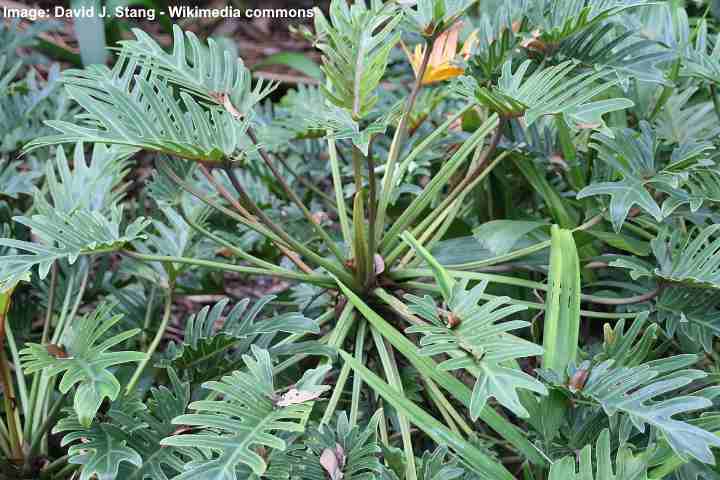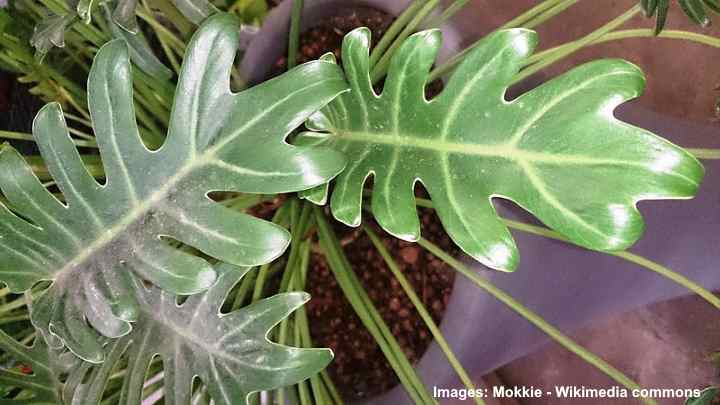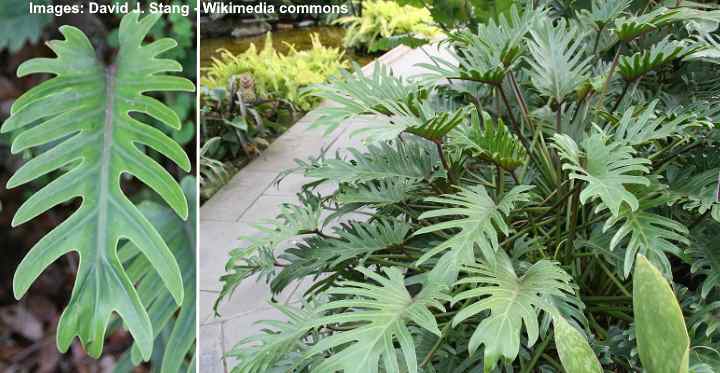The glossy green, deeply lobed leaves of the Philodendron Xanadu (Philodendron bipinnatifidum ‘Xanadu’) make it an evergreen tropical plant. The Xanadu plant is a simple-to-care-for houseplant that thrives indoors. This tropical indoor plant grows to around 5 feet (1.5 meters) tall and is also known as the Philodendron Winterbourn. You may easily cultivate a Philodendron Xanadu indoors if you take care and pay attention.
How to care for Philodendron Xanadu? Water the top 1 in. (2.5 cm) of potting soil to keep it moist when growing your Xanadu plant in rich, well-draining soil. During the growing season, fertilize your Xanadu plant monthly and keep it indoors in bright, indirect light.
Keep the temperature between 65°F and 82°F (18°C and 28°C) with high humidity. The Xanadu plant is a flowering tropical plant that is commonly referred to as Philodendron Winterbourn. The plant thrives in tropical and subtropical climates in its natural environment. The dark red spathes of the Philodendron Xanadu bloom outdoors. The plant, however, seldom blooms indoors.
The fast-growing Xanadu plant, which has lustrous, thick leaves and grows in dense clumps up to 6.5 feet (2 meters) broad. This article covers everything you need to know about keeping a Philodendron Xanadu plant healthy indoors. Keep your tropical houseplant healthy and disease-free by following these helpful growing tips.
What is a Philodendron Xanadu?

The plant family Araceae encompasses all varieties of Philodendron. The Philodendron bipinnatifidum species cultivates the Xanadu cultivar. Instead of a trailing vine plant like the heartleaf Philodendron, this species of Philodendron is a clumping plant.
The deeply lobed leaves of the Philodendron Xanadu are a distinguishing characteristic. Waxy leaves develop long finger-like formations along their leaf stalks as they grow and mature. The massive leathery leaves, up to 15″ (40 cm) long and 11″ (30 cm) broad, are big enough to be seen from afar.
Philodendron Xanadu Plant Care
The Xanadu cultivar, like other Philodendron species, is a simple houseplant to maintain. To ensure that you develop a healthy plant indoors, however, there are a few essential care requirements. The following are the most important aspects of caring for a Xanadu plant:
- To promote thick foliage development, it must receive enough bright, filtered sunlight.
- To avoid root disease, plant in a well-draining potting soil.
- To help the plant flourish indoors, keep humidity at a high level.
Light Requirements for Philodendron Xanadu

In a bright area with filtered or indirect sunlight, grow the Philodendron Xanadu. The robust stems are prevented from becoming leggy and unattractive in medium to bright light. The sun’s rays can bleach the dark, green glossy leaves of the houseplant, so protect it from direct sunlight.
Shaded areas or low-light conditions are ideal for most types of Philodendron plants. The Xanadu plant, however, requires more sunlight than most Araceae plants. Slow growth that becomes sparse and leggy is one indication that your plant isn’t getting enough light.
Stems may produce leaves with several inches of space between them instead of thick growth. As a result, dark places, shaded edges, and north-facing rooms are not ideal locations for Xanadu plants.
Other care requirements will be affected by enough bright light. You’ll have to water your plant more often if the indoor environment is bright and sunny. You’ll need to change your watering schedule when a Philodendron grows in medium light. You may need to relocate the plant to a brighter location if it develops weak growth habits.
Philodendron Xanadu Soil Mix
A rich, loose soil combination that drains well is required for Potting Soil for Philodendron Xanadu. Just enough water should be retained in the right soil mix, without it becoming too wet or waterlogged. Water should drain quickly from the drainage holes in the best soil type.
What are the best plants for growing Philodendrons, such as Xanadu? To keep the potting soil from drying out too quickly, it should be high in organic matter such as peat moss. Perlite, charcoal, and coconut fibers may also be used to fertilize the soil. For your tropical plant, a light potting soil is ideal. 100% sphagnum peat moss will also support these plants.
If you notice any of the following signs, you should consider switching to a different potting soil:
- Since it is too thick, water does not drain well.
- Growth of the Philodendron is slower than normal.
- Because it’s too heavy, or the plant is rootbound, water pools on the soil’s surface.
You might learn how to repot a Philodendron Xanadu later in the article.
How to Water Philodendron Xanadu

After the top layer of soil has dried out, water a Philodendron Xanadu. Press hard on the ground to see if the plant needs watering. Make sure to thoroughly water the plant if there is no sign of moisture. If there is still moisture in the pot’s soil, wait a few days for it to dry.
In order to care for your Xanadu properly, you’ll need to use the right watering method. It is preferable to water less rather than more with a variety of indoor plants, such as the Xanadu. Fungal infections may harm your plant if you overwater it. Dehydration of your plant can occur if it is watered too much.
Remember that saving a waterlogged plant is more difficult than reviving an underwatered Philodendron. Your Philodendron Xanadu will live for many years if you always follow soil dryness as a guide to watering your plant. Before soaking the soil, make sure that the top 1″ to 2″ (2.5 to 5 cm) has been thoroughly dry.
Why is it preferable to provide a Philodendron with ample water rather than a little? The roots can receive enough moisture because to deep watering. Plant growth is aided by healthy roots, which make it resistant to disease. You risk damaging your plant if you water it too little and frequently. Shallow watering promotes fungus gnats and white plant mold to flourish, while depriving roots of moisture.
Top care tip: Never put a philodendron in water, or the roots will be damaged.
Philodendron Xanadu Temperature Requirements
In typical household room temperatures, Philodendron Xanadu plants thrive. Between 65°F and 82°F (18°C and 28°C) is the ideal temperature range. If the minimum temperature is 73°F (23°C), you might observe that the plant grows faster. Avoid temperatures below 55°F (12°C) if you grow your Philodendron outdoors in a container.
Even temperatures are required for tropical plants like Philodendron, Monstera, and hanging basket Pothos. Thus, try to keep the temperature in your house steady. In hot or cold weather, maintaining a comfortable temperature may be difficult. Throughout the various seasons, here are some tips for growing Philodendrons:
- Growing Xanadu plants in summer—Drafts from open windows or doors should be avoided when storing plant pots. If the plant is in the air-condoning airflow, relocate it. Don’t let the plant shine through a window and get hit by the hot sun’s rays.
- Growing Philodendron Xanadu in winter—From hot surfaces such as radiators, protect the plant. Heating may make indoor air drier, so check the plant’s humidity levels.
How to Care for Philodendron Xanadu: Humidity

Your Philodendron Xanadu thrives in high humidity conditions. Several tropical plants, including Xanadu, prefer to grow in household air that is too dry. For fast, healthy growth, humidity levels must be increased to at least 40%. Regular misting, a pebble tray, or a humidifier may all be used to boost air moisture.
How can you ensure that your tropical Xanadu plant receives enough humidity? Ways to take care of your plant include:
- Mist the leaves—Fill a spray bottle with filtered or distilled water. To assist keep the plant’s leaves moist and humid, spray a thin mist onto them every day.
- Use a humidifying tray—Pour enough water halfway up the pebbles in a shallow tray until it is full. Place the plant pot on the stones. When the water has evaporated, replenish the tray as necessary.
- Use a room humidifier—Your room’s humidity levels may be kept at appropriate levels by using a humidifier. Excellent shower plants include Philodendron Xanadu. The typical humidity from showers will assist your plant flourish if you have a well-lit bathroom.
Fertilizer Needs to Care for Philodendron Xanadu
A well-balanced houseplant food mixed with half is used to fertilize a Philodendron Xanadu. In the spring and autumn, feed your Xanadu plant. Fertilize the potted plant every two to three weeks throughout the summer, when growth is vigorous. Late in the autumn and winter, don’t feed your Philodendrons.
They may accumulate fertilizers, like other tropical houseplants like Philodendron Xanadu. That’s why feeding them too much is a bad idea. The roots can be damaged if too much fertilizer is used, resulting in poor development and yellow foliage. Harmful chemicals and a salt buildup in the soil may be removed by flushing the soil on a regular basis.
Let the water drain gently through the potting mix for a few minutes to flush fertilizers from houseplant soil. Return the plant to a bright location after allowing all of the excess water to drain out.
Repotting Philodendron Xanadu

To encourage healthy growth, you’ll need to repot a Philodendron Xanadu or Winterbourn every year or two. The potting mix may be replaced with fresh soil if you repot your plant. Furthermore, if the roots have become rootbound, transferring the plant to a bigger pot allows it to expand.
Choose a pot that is 1″ to 2″ (2.5 to 5 cm) bigger than its current size as a rule of thumb. You’ll need a good drainage potting soil. It’s a smart idea to use pruning shears to cut away any dead or rotting roots before repotting. Repotting a Philodendron Xanadu also allows you to divide the plant and reproduce it. This is what you should do to repot your Philodendron Xanadu:
- Remove the Xanadu plant from its present pot and shake off any excess soil.
- Damage to the Philodendron roots should be inspected. Trim off any brown mushy roots you may find.
- Using the correct Philodendron potting soil, fill a new container half-full.
- Plant the Philodendron Xanadu again. Make sure the plant is growing at the same level as it was previously.
- Potting soil should be used to fill the empty space.
- Make sure to water the Xanadu facility well.
- In an indoor location with medium to bright light, place the Philodendron Xanadu.
Pruning a Philodendron Xanadu
Trimming a philodendron xanadu isn’t usually required. You may, however, cut off some of the stems if the plant’s development gets leggy or it becomes too big. If dead or dying leaves appear, pruning may be necessary. Just cut off the leaves at the base of the stem to trim your Xanadu plant.
Philodendron Xanadu Propagation
The best way to propagate a Philodendron Xanadu is to divide it. The Xanadu can quickly become too big for its pot because this variety is a fast-growing plant. When you repot a Xanadu, it’s the easiest time to split it. You may increase two additional plants and offer one as a present in this manner.
This is what you should do to propagate a Philodendron Xanadu plant:
- Remove the Xanadu plant from its pot with care.
- Since they’ll most likely be intertwined, gently pull the roots apart.
- Divide the root ball of the Xanadu plant into two.
- Check for and remove dead roots just as you would when repotting.
- Both plants should be repotted in new pots.
Continue watering both plants as usual when the soil is partially dry after propagating a new plant.
Treating Philodendron Xanadu Pest Infestations
Houseplant pests can affect Philodendron Xanadu. Any houseplant insect infestations should be handled promptly. The insects might kill your plant and spread to other indoor plants if they are not controlled. Neem oil, a natural pesticide, can be used to treat these pests. Identifying the type of bug on your plant is required for successful pest removal. For further information, see this page on identifying houseplant pests.
One way to avoid certain pests is to watering properly. Spider mites, for example, prefer dry air and are helped to avoid them by maintaining humidity levels high. Fungus gnats thrive in damp conditions near the soil surface, so allowing the top layer of soil to dry before watering helps prevent them.
Philodendron Xanadu Diseases
If you don’t care for Xanadu plants properly, they are vulnerable to bacterial or fungal infections. Indoor plant illness can be avoided by watering them properly. To avoid too much soil moisture, let the soil to dry partially between deep watering. Fungal spores can grow in soggy or waterlogged soil if it isn’t properly removed.
Root rot and leaf spot are two bacterial diseases that affect roots. You should repot the plant to refresh the potting mix if you notice signs of plant disease. To prevent soggy soil, water the Philodendron only when it needs it.
Is Philodendron Xanadu Plant Poisonous?
Because it contains calcium oxalate chemicals, the Philodendron Xanadu is dangerous. Philodendron plants are poisonous to cats and dogs, according to the American Society for the Prevention of Cruelty to Animals (ASPCA). Pets may experience strong burning, inflammation, nausea, and difficulty swallowing after eating Philodendron leaves.
FAQ About Philodendron Xanadu Care
Why are the leaves of Philodendron Xanadu turning yellow?
On a Philodendron Xanadu, leaves can yellow for a variety of reasons. Too much sunlight is, however, the most prevalent cause of yellowing leaves. Therefore, shift your plant away from the sun or filter the light to prevent it from hitting you. Overwatering can also cause yellow leaves. Make sure the pot has enough drainage and that you only water when the soil is partly dry.
Why are leaves of Philodendron Xanadu turning brown?
Watering problems may be the cause of brown deposits on your Philodendron Xanadu leaves. The roots aren’t getting enough moisture, which is why brown leaves appear. As a result, make sure to thoroughly water your plant until the water runs out at the bottom. Watering your plants excessively and shallowly may kill them due to thirst, so avoid that.
How do you fix an overwatered Philodendron Xanadu?
To restore a plant that has been watered excessively, there are two options. Instead, wait until the top layer of soil has dried before watering the plant. Second, replace the growing soil with fresh potting soil that drains well after you repot your plant.
How do you revive a dying Philodendron Xanadu?
Investigate the cause of why a wilting Philodendron Xanadu needs to be resurrected. Make sure there isn’t a problem with watering by testing the soil’s moisture. Also, on your plant, check for signs of pests or bugs. You may have to replant the plant in order to help it recover.
